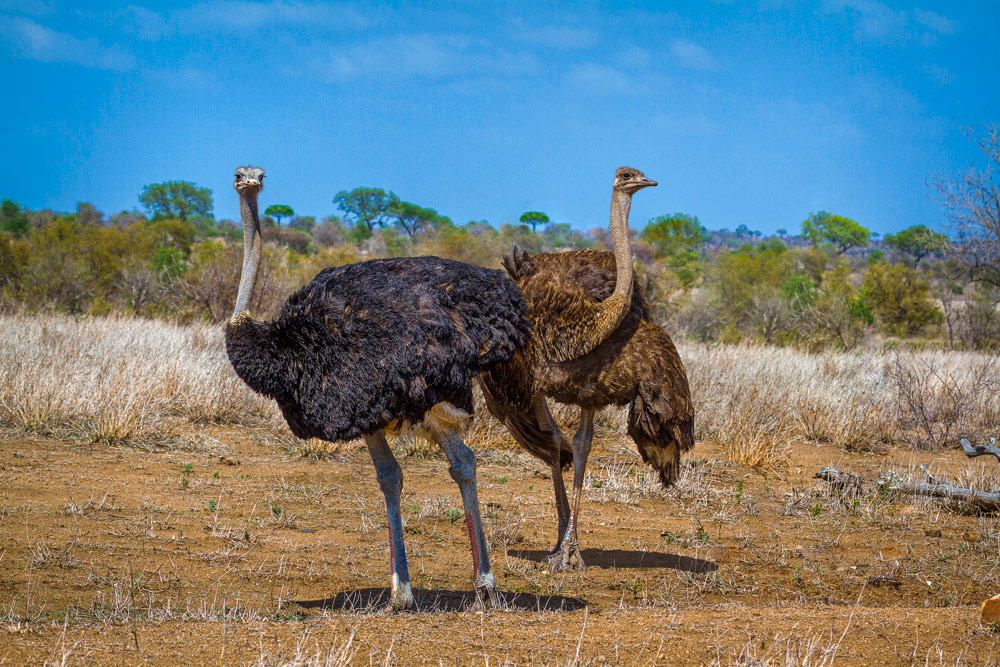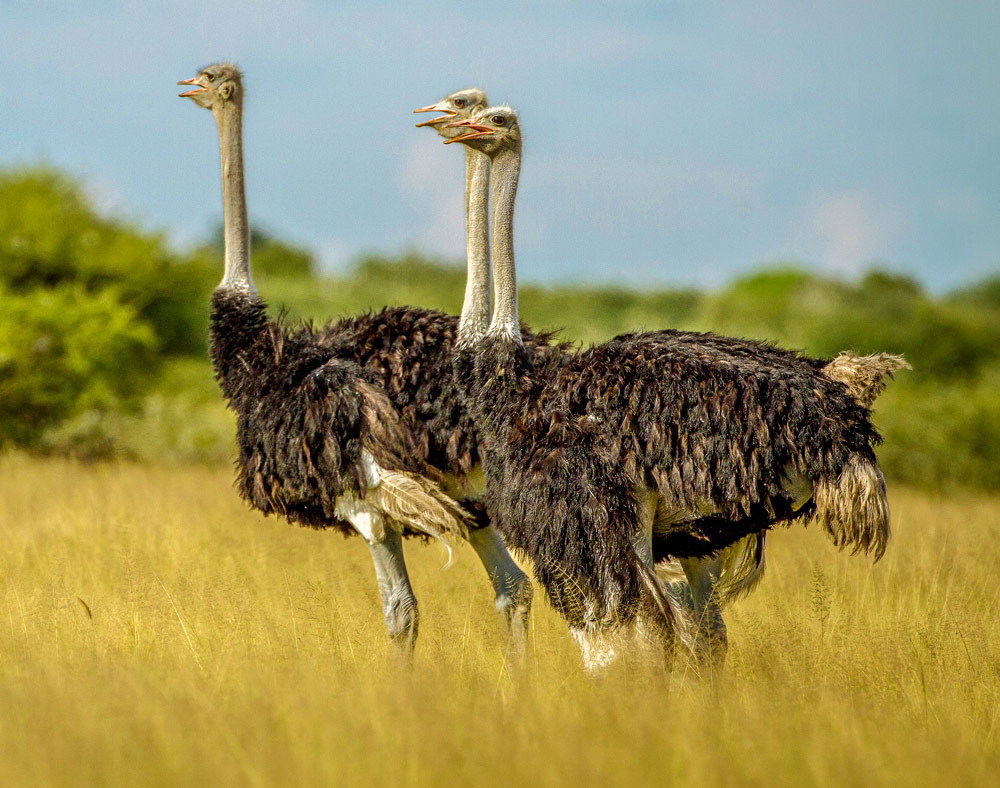The ostrich—a reminder of creation and the Fall

When we consider the marvellous design aspects of bird flight, flightless birds like the ostrich provide an unusual counterpoint. Were they created that way, or has flightlessness resulted from degeneration causing loss of function?1
Creationist biologists generally think that most flightless birds, if not all, had flying ancestors—and this includes the ostrich. And in this they are in general agreement with evolutionists.
The ostrich is one of the ratites—a group of flightless birds consisting also of cassowaries, emus, kiwis, rheas, and the extinct moa and elephant bird. Evolutionists once thought that all of these belonged to the same order, Struthioniformes, descended from one ancestor which had lost the ability to fly. However, genetic analysis has caused a rethink. For one thing, the huge moas of New Zealand, wiped out by indigenous overhunting, seem most closely related to the tinamous, small birds that can fly. So, it is now thought that flightlessness arose independently in the ratites multiple times.2
Hard to make, easy to break
It’s actually very easy for creatures to lose complex abilities such as flight. In certain environments, being unable to fly aids survival. For instance, on small windy islands, a creature that can’t fly is at less risk of being ‘lost at sea’ in storms and thus no longer able to reproduce. So, when a genetic accident (mutation) cripples some part of the complex flight machinery, the flightless form, which would normally be eliminated as defective, is very likely to dominate the island population. Thus, islands are common places to find flightless birds (and insects). The flightless cormorant of the Galápagos, shown on CMI’s Darwin documentary The Voyage That Shook the World, is a classic example.

Such devolution has nothing to do with how flight arose in the first place, which requires new, complex genetic information to arise. Even dedicated evolutionists don’t suggest that any flightless bird ever ‘re-evolved’ flight ability once lost.
Big bird
At around 2.7 m (9 ft) high and weighing up to 140 kg (300 lb), the ostrich is the tallest and heaviest of living birds, with the largest egg.
Though unable to fly, the ostrich has design features highly suited to running. This suggests that the information permitting this to come to the fore after it lost flight ability was in the original kind already.3
Run as fast as you can
Most of the ostrich’s leg musculature is positioned high up on the hip and thigh-bone, generating a long step length (5 m or 16 ft) and a high step frequency that helps produce fast speeds. Its leg ligaments restrict most types of movement other than guiding the leg through its stride. Thus, unlike the human leg which is designed to be able to jump, climb, side-step, etc., the ostrich’s muscle power is almost exclusively devoted to propelling the ostrich forward.4

A 2010 study at the University of Western Australia compared running in ostriches and humans of similar masses.5It was known that the birds use 50% less energy than humans when running at a given speed. The study confirmed that this was mainly due to the way in which the ostrich leg stores and releases elastic energy. Its ankle ligaments keep the joint extended until downward force is applied. It requires approximately 28 kg (60 lb) of force (half for each leg) to collapse the ankle joints into a flexed position, in effect passively supporting 28 kg of the bird’s weight.
Leader of the study, Professor Jonas Rubenson, said, “Moving with elastic limbs is akin to bouncing on a pogo stick, where you don’t have to work very hard to bounce along—so it’s all in the spring of their step.”6
The ostrich is the only bird to have two toes on each foot, and the only one that walks on the tips of its toes. This spring-loaded posture acts as an additional shock absorber. Though the toe claw barely touches the ground when walking, it penetrates like a hammered spike when running, exerting pressure of up to 3.9 MPa (570 psi). This provides excellent grip at high speeds.4 The findings may one day help engineers design better prosthetic limbs for double amputees, as well as designing more agile robots.6
The ostrich has the fastest land speed of any living bird (even faster than some can fly!) at 72 km/h (45 mph). While there are a few predators that can catch the adult ostrich (e.g. the lion and cheetah), they can do so only with rapid acceleration, using large amounts of energy to reach that velocity. Unless their prey is quickly caught, the pursuers will soon fall by the wayside, as the ostrich can maintain speeds of 55–60 km/h (34–37 mph) over extended periods. Additionally, to deter predators the ostrich has a powerful kick that can kill a human.7
High speed is a great attribute if you’re running in a straight line, but what if you need to turn? As a ‘leftover’, the ostrich’s 1.8 m long wing (6 ft) used to be thought of as used for nothing more than courtship and perhaps temperature regulation and swatting flies. But its wings are also used as advanced air-rudders, able to efficiently channel aerodynamic forces and so be actively involved in rapid braking, turning and high-speed zigzag manoeuvres.8

Ostrich mothers and Job
The ostrich has the special distinction of being directly spoken about by God in Job 39:13–18:
The wings of the ostrich wave proudly,
but are they the pinions and plumage of love?
For she leaves her eggs to the earth
and lets them be warmed on the ground,
forgetting that a foot may crush them
and that the wild beast may trample them.
She deals cruelly with her young, as if they were not hers;
though her labor be in vain, yet she has no fear,
because God has made her forget wisdom9
and given her no share in understanding.
When she rouses herself to flee
she laughs at the horse and his rider.
We read of a creature whose behaviour seems foolish, even callous, not sounding like a part of God’s original ‘very good’ creation. This reminds us that all nature is fallen due to man’s rebellion (Genesis 3, Romans 8:20–22); flight may not have been the only thing about ostriches that has degenerated post-Fall.
Most of the passage refers to the nesting and chick-rearing habits of the female ostrich. During the egg-laying period, the male performs an impressive courtship dance, mating with multiple females (usually between 2 and 7).10 One of these will be chosen by the male as the main hen that partners with the male during incubation. The male scrapes out a simple pit in the ground, 30 to 60 cm (1 to 2 ft) deep and up to 3 m (10 ft) wide. This functions as a communal nest. All the females of that male’s pairings will lay their eggs in this pit, commencing with the main hen.11 The subordinate females may also lay some of their eggs in the nests of other males. They show little concern for their eggs unless they are chosen as the main hen.
Some nests have over 60 eggs. But only about 20 can be incubated and the main hen, which prefers eggs she recognizes as her own, shifts many of the others beyond the edge of the pit where they are at the mercy of various predators.

Newly-hatched chicks are especially vulnerable to attack, with only about 15% surviving to maturity.10 Flocks of chicks from different nests may merge together, with only one set of parents (or one male) staying with the group. Parents devoid of any chicks simply leave.
Of course, the Job passage does not indicate that ostriches are devoid of any parental instincts. But we see, allowing for some poetic language, a realistic description of the bird’s nesting behaviour.
Whose head is buried in the sand?
People who ignore an unpleasant issue or problem are said to have buried their head in the sand, deriving from the long-debunked myth that the ostrich does this when danger threatens. Yet given all the evidence supporting the creation account, when we continually read about evolutionary make-believe, it’s clearly not the ostrich with its head in the sand, but those who refuse to love the truth (2 Thessalonians 2:10).
Evolution, ratites, and created kinds
The alleged evolution of the ostrich is said to commence with Remiornis heberti of the Paleocene (66–56 Ma) and Palaeotis weigelti of the Eocene epochs (56–33.9 Ma),1 ratite fossils described as ostrich-like. Other unspecified ratite remains from Europe and Africa are considered questionable relatives of the ostrich. Modern ostrich fossils are said to appear from the early Miocene (23–5 Ma) onwards.
Hybridization studies, not yet available, could help to determine how many created kinds are within the ratites, and thus how many times flightlessness arose. A renowned world expert in the evolutionary ‘trees’ constructed from bird genomes was the late Dr Jon Ahlquist, who in recent years became an out-and-out biblical creationist.2 He thought that the genetic data was most consistent with ratites and tinamous having descended from one ancestral (flying) population that came off the Ark.3 Other creationist researchers think ratites likely represent more than one kind, each originally flying.
What seems certain is that all in the genus Struthio are the same kind as the common ostrich (Struthio camelus). The other living species is the Somali ostrich (Struthio molybdophanes), with blue neck and legs. Some regard it as a mere subspecies of the common ostrich. The other three known subspecies are the Masai ostrich, the southern (or South African) ostrich, and the red-necked (or North African) ostrich.
- Ma = million years (mega-annum), the assumed evolutionary age that in reality reflects the order of burial in the global Flood.
- Wieland, M., Convert to Creation, Creation 40(3):36–39, July 2018; creation.com/jon-ahlquist.
- Personal communication from Jon Ahlquist to CMI, 7 May 2019.
References and notes (main article)
- See creation.com/vestigial-organs-what-do-they-prove. Return to text.
- Baker, A.J. et al., Genomic Support for a Moa–Tinamou Clade and Adaptive Morphological Convergence in Flightless Ratites, Molecular Biology and Evolution, 31(7):1686–1696, Jul 2014, academic.oup.com. Return to text.
- Creationist researchers have written recently about the way many creatures seem genetically ‘frontloaded’ for subsequent adaptation—e.g. creation.com/frontloaded. Return to text.
- Schaller, N., Birds on the run: what makes ostriches so fast? scienceinschool.org, 22 Nov 2011. Return to text.
- Rubenson, J. et al., Adaptations for economical bipedal running: the effect of limb structure on three-dimensional joint mechanics, royalsocietypublishing.org, 28 Oct 2010. Return to text.
- Firth, N., How ostriches use their ‘springy’ legs to help them run faster and longer, dailymail.co.uk, 1 Nov 2010. Return to text.
- Usurelu, S., Bettencourt, V., and Melo, G., Abdominal trauma by ostrich, Annals of Medicine and Surgery 4(1):41–43, Mar 2015, sciencedirect.com. Return to text.
- Feathered friends: Ostriches provide clues to dinosaur movement, sciencedaily.com, 2 Jul 2010. Return to text.
- The KJV here says God has “deprived her” of, i.e. withheld, wisdom, consistent with the 2nd part of this parallelism. Return to text.
- Cooper, R.G. et al., Wild ostrich (Struthio camelus) ecology and physiology, academia.edu , 20 Aug 2009. Return to text.
- See youtube.com/watch?v=QTMxj_QL5U4. Return to text.


Readers’ comments
Comments are automatically closed 14 days after publication.